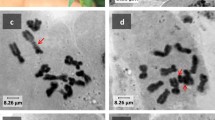Summary
-
(1)
In rye, a small chromosome derivative possessing a deleted kinetochore is studied throughout meiosis and at metaphase of mitosis. Its kinetochore has, at pachytene, approximately one third the length of the normal kinetochore and is constituted by a weakly stained fibrilla pair and a chromomere pair. These two components are considered to correspond to half of the exterior and median zones of the normal kinetochore.
-
(2)
The chromosome derivative has essentially the same ability to move to the spindle poles as a chromosome with a normal kinetochore, since it is not eliminated during the mitotic divisions leading to the formation of the roots and the flowers, and since its degree of elimination is very small at both meiotic divisions. It occupies in the mitotic metaphase plate a central position similar to that of other small chromosomes with normal kinetochore. It also divides regularly at the first division of meiosis, elimination and non-disjunction seldom occurring.
-
(3)
Its behaviour differs from that of chromosomes with a normal kinetochore in that it suffers very little elimination at the second division of meiosis. Usually, rye univalents with a normal kinetochore which divide at the first division lag and are eliminated to a large extent at the second division. Moreover, its condensation cycle diverges from that of the A chromosomes. At pachytene it is about 16 times smaller than an A chromosome whereas at metaphase II it is only three times smaller.
-
(4)
At pachytene the single chromosome derivative becomes split into two clearly individualized sister chromatids earlier than the A chromosome bivalents. However, the chromatids do not separate at diplotene and the chromosome continues condensing until metaphase I where it looks like a dark round body. The two hidden chromatids only separate at middle anaphase I. Chromatid individualization does not necessarily lead to an immediate separation—the timing of the two processes being distinct.
-
(5)
The chromosome derivative was found in the third generation of a plant where another chromosome type with a normal kinetochore showed at pachytene non-homologous pairing and chiasma formation between its arms. Crossing over involving the kinetochore and one arm may account for the formation of chromosome types with an incomplete kinetochore as is the case of the chromosome derivative.
Similar content being viewed by others
Literature cited
Darlington, C. D.: Misdivision and the genetics of the centromere. J. Genet. 37, 341–364 (1939).
—: The origin of iso-chromosomes. J. Genet. 39, 351–361 (1940).
Lima-de-Faria, A.: B chromosomes of rye at pachytene. Portug. Acta Biol., Ser. A 2, 167–174 (1948).
—: The structure of the centromere of the chromosomes of rye. Hereditas 35, 77–85 (1949).
—: The Feulgen test applied to centromeric chromomeres. Hereditas 36, 60–74 (1950).
—: Chromomere analysis of the chromosome complement of rye. Chromosoma 5, 1–68 (1952).
— The regions of special cycle of division of Agapanthus chromosomes. Chromosoma 6, 33–44 (1953a).
- Structure and properties of the kinetochore. Proc. IXth Intern. Congr. Genetics (1953 b in the press).
—: Chromosome gradient and chromosome field in Agapanthus. Chromosoma 6, 330–370 (1954).
McClintock, B.: Cytological observations of deficiencies involving known genes, translocations and an inversion in Zea mays. Agric. Exp. Station Res. Bull. 163, 1–30 (1931).
—: The production of homozygous deficient tissues with mutant characteristics by means of the aberrant mitotic behaviour of ring-shaped chromosomes. Genetics 23, 315–376 (1938).
Müntzing, A.: Apomictic and sexual seed formation in Poa. Hereditas 17, 131–154 (1933).
—: Cytological studies of extra fragment chromosomes in rye. I. Iso-fragments produced by misdivision. Hereditas 30, 231–248 (1944).
—: Cytological studies of extra fragment chromosomes in rye. IV. The position of various fragment types in somatic plates. Hereditas 34, 161–180 (1948).
- Accessory chromosomes in Secale and Poa. Proc. VIIIth Intern. Congr. Genetics (1949), 402–411.
—: Cyto-genetic properties and practical value of tetraploid rye. Hereditas 37, 17–84 (1951).
- Cyto-genetics of accessory chromosomes (B chromosomes). Proc. IXth Int. Congr. of Genetics (1953, in the press).
Müntzing, A., and A. Lima-de-Faria: Pachytene analysis of standard fragments and large iso-fragments in rye. Hereditas 35, 253–268 (1949).
—: Pachytene analysis of a deficient accessory chromosome in rye. Hereditas 38, 1–10 (1952).
—: Pairing and transmission of a small accessory iso-chromosome in rye. Chromosoma 6, 142–148 (1953).
- Sturtevant, A. H., and G. W. Beadle: An introduction to genetics. Philadelphia and London 1940. p. 391.
Author information
Authors and Affiliations
Rights and permissions
About this article
Cite this article
Lima-de-Faria, A. Structure and behaviour of a chromosome derivative with a deleted kinetochore. Chromosoma 7, 51–77 (1955). https://doi.org/10.1007/BF00329719
Received:
Issue Date:
DOI: https://doi.org/10.1007/BF00329719



